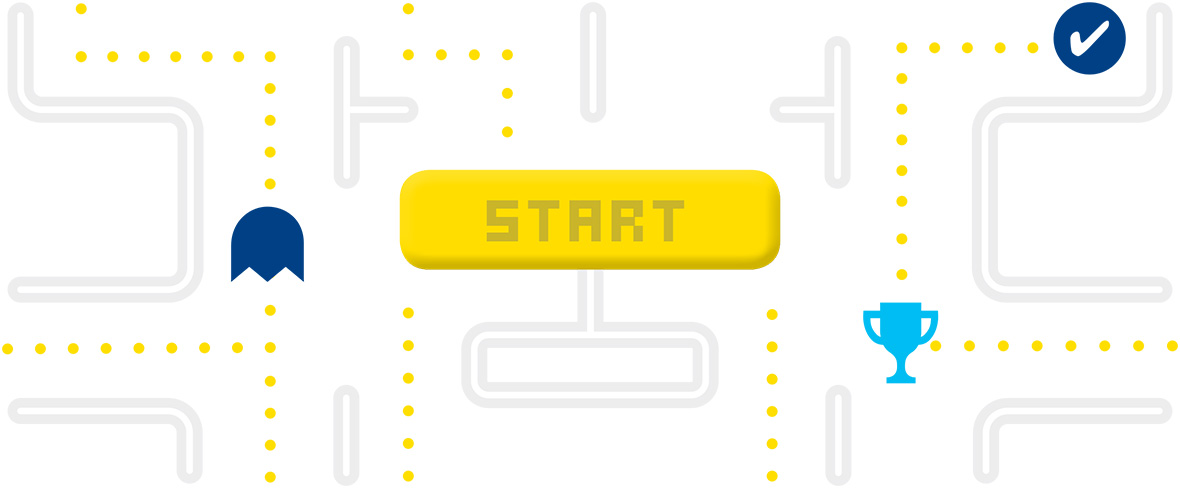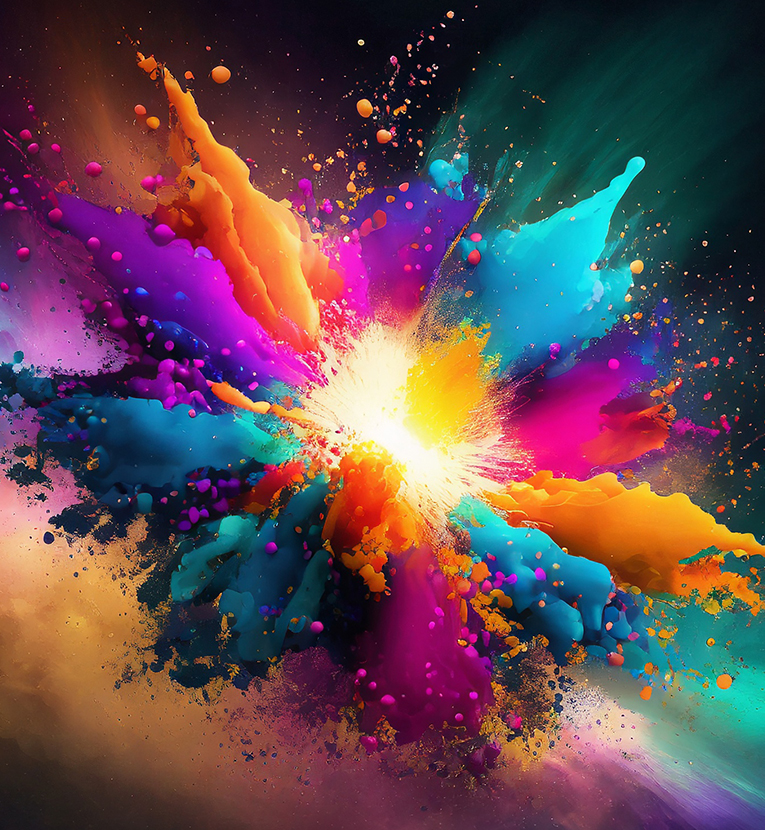Are you ready? Let’s PLAY!
Human beings are hard-wired to enjoy the competition and status that games provide. And the prospect of entertainment – and winning! – is an attraction that’s hard to resist. You probably felt a subconscious jolt of anticipation when you saw the above invitation to play. Adding game mechanics or techniques immediately increases interest and participation in any given activity. Gamification applies game design principles in non-game settings as a way to create engagement – which can increase brand loyalty and profits.
Whether you “gamify” your communications with points, rankings, badges, contests or interactive communities, gamification can help brands and messages stand out from the crowd. It’s perfect for B2C applications that resonate with consumers and help them move through the sales funnel. But gamification isn’t just for consumers. Game techniques can motivate employees to participate in – and spread the word about – corporate programs. B2B marketers should note that Autodesk successfully used game techniques to help convert in-trial prospects.1
What are the basics of gamification? How can game techniques be used? What are some examples of successful gamification in marketing campaigns? This paper provides the answers to these questions – and more.
Gamification on the rise
Gamification isn’t a new concept. Companies have long used points programs and interactive features to reward loyalty or create interest. However, more companies are considering gamification now based on high-profile success stories. In fact, in 2014 more than 70% of the world’s largest 2,000 companies reported that they expect to deploy at least one gamified application.2
Why do games engage us?
Game techniques build a connection to your audience that is based on visceral needs. Let’s take a look. The immensely popular Game Theory series on YouTube examines individual video games in great detail, explaining the appeal of each game in a historical, cultural and even philosophical context. The Game Theorists’ special “Why You Play Video Games” opines that the reason video games charm us is that they fulfill our basic needs for:
- Competence – achieving mastery
- Autonomy – being in control
- Relatedness – connecting to others (in a sometimes isolated world)3
The factors that make video games appealing apply to other game formats as well, because games seduce us by meeting these core needs in an easy, low-risk way. As Steve Keil reminds us in his TED Talk on the benefits of play,4 evolution has selected for play. Animals who play have healthier brain growth and are more social. The more we play, the better our cognitive development and emotional maturity. Play is so powerful because it’s universal to the human experience.
Tapping into generational preferences
Games are incredibly appealing to Generation Y, those people born between 1980 and 2000 who now make up 25% of the workforce and will continue to increase in numbers.5 This demographic grew up online, is used to being hyper-connected and happens to love both online games and social media. So with this age group, gamified applications and communications are – if you’ll excuse the pun – an instant win. However, games also resonate with those over age 35 who enjoy connecting and competing. It’s that impulse to have fun at any age.
Game techniques build an emotional connection to your audience, leading to a longer relationship as opposed to simple brand awareness.2
What people are saying
“Gamification is as important as social and mobile.”
– Bing Gordon6
“The biggest mistake I see made is when marketers forget that the relationship needs to be mutually beneficial – meaning that they need to be acknowledging these messages and fueling them with rewards. One way to make relationships mutually beneficial is through rewarding consumers for sharing socially and making it fun and worthwhile to help share your brand’s message.”
– Kristin Matthews2
“The coming business cycle is sure to include many demographically driven changes and gamification presents a rare opportunity for companies to address the needs of next-gen employees, while also improving productivity, increasing collaboration, minimizing turnover, improving employee morale, more effectively leveraging social media and driving business opportunities.”
– Katherine Heisler5
“In every job that must be done there is an element of fun.”
– Mary Poppins6
How we like to play
Different players, different motivations
Game content should be geared to how people are motivated, because different groups have fun in different ways. Richard Bartle, a game creator and academic, developed a player typology during the 1980s.7 His well-known player classification system helps define design patterns in gamification. You may recognize these player types, for they describe both how we like to play games – and how we like to interact with the world.
Challenge: What kind of player are YOU?
Find out
What kind of player are you?
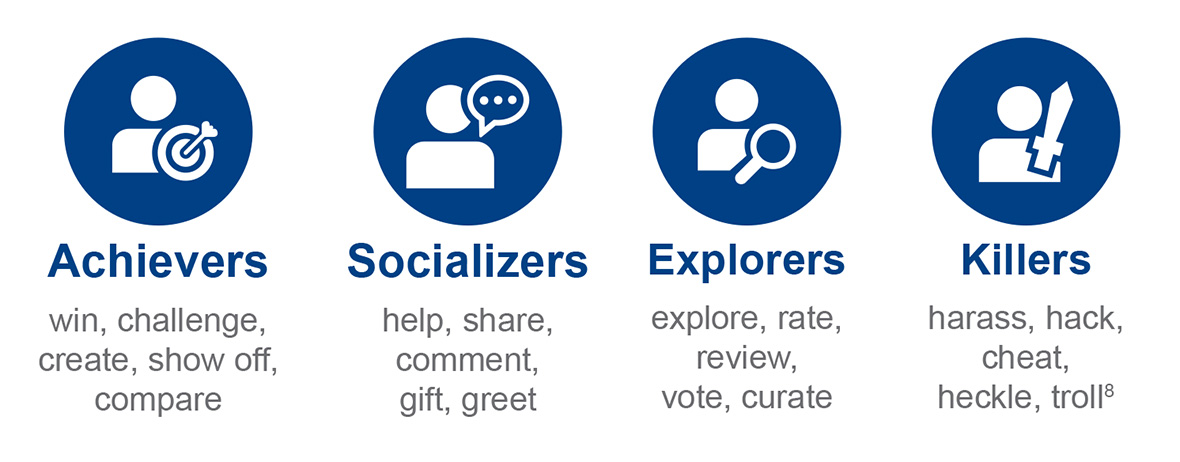
Calling all players
To meet the needs of the various player types who make up the audience for your gamified communication, make sure you consider their personalities and the tactics that may work for them.7,8
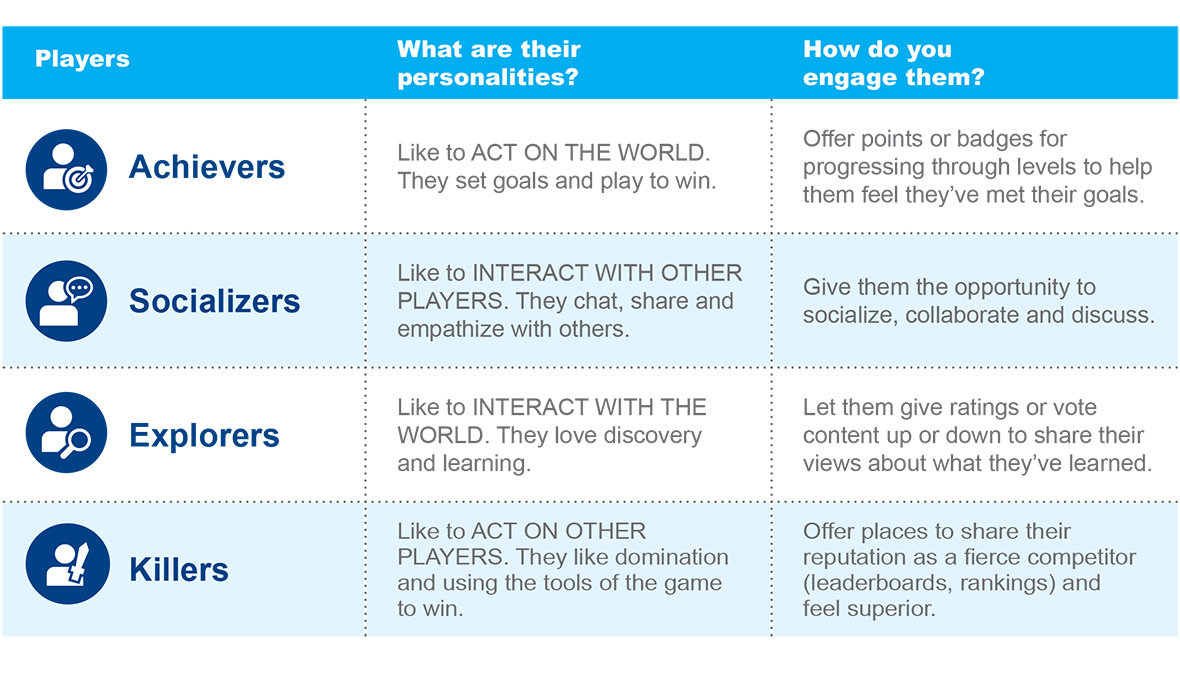
Using game techniques
Remember, games are all about rewarding people. These are the basic techniques:
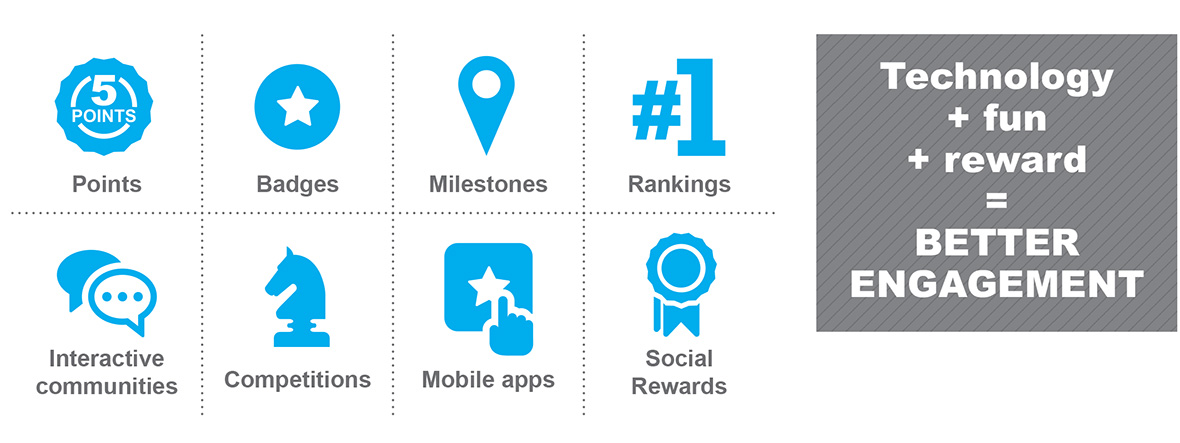
Companies across industries have used the techniques above to their advantage. We’ve collected information about some real-world ways to incorporate gamification:
- Recyclebank uses points to educate. Points have long been used to track and motivate. The familiar hotel and airline loyalty programs use points (or miles) as virtual currency to reward customers for business volume. Recyclebank has taken this classic game technique to the next level, offering points to users for completing interactive lessons about the importance of recycling.9 Users can redeem their points for discounts, gift cards, magazine subscriptions and more.
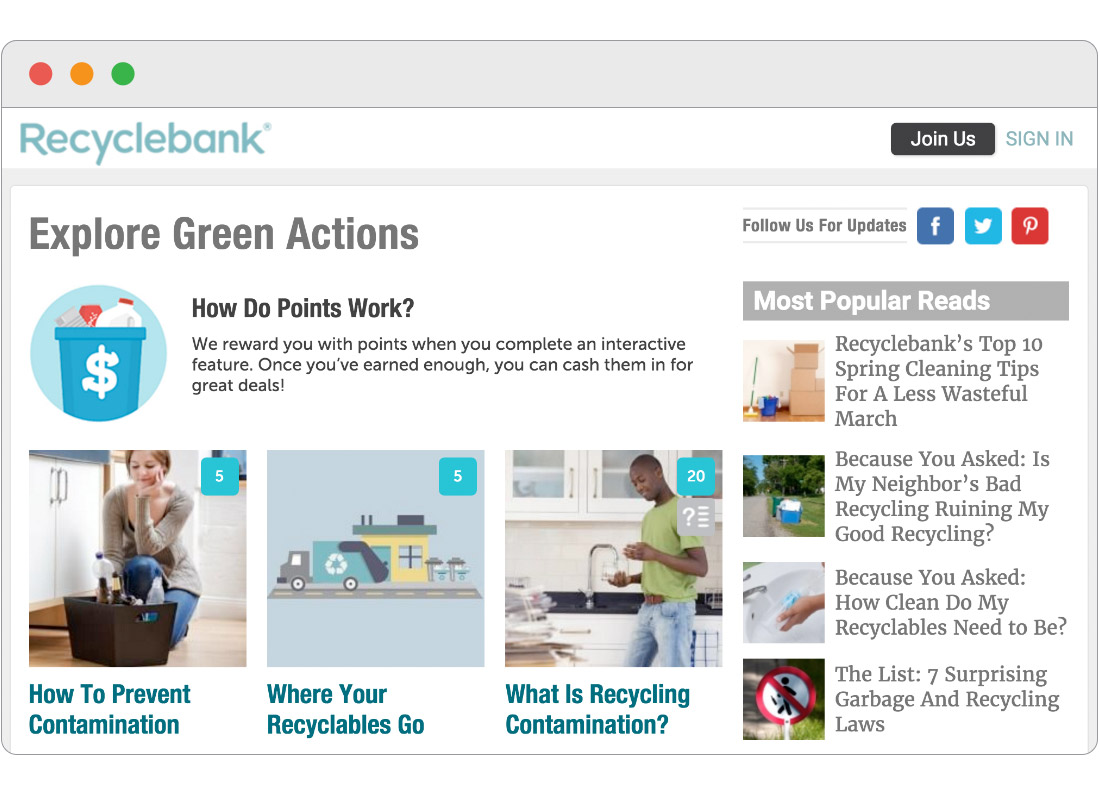
- Badges showcase status. If you were ever in the Girl or Boy Scouts, you’ll remember the thrill of earning badges for skills like first aid or camping. Merit badges feed our adult need for achievement as well, denoting a certain level of accomplishment. Many websites including Amazon, Yelp and Rotten Tomatoes rate users’ activity with badges such as “Rookie,” “Top User” or “Super Reviewer.” Other users recognize and value top users’ inputs. And those users get the satisfaction of being recognized as go-to experts.
- Milestones tap the power of incremental progress. Working through steps or levels towards a larger, meaningful goal is an incentive. The ubiquitous rewards cards that offer a free sandwich or cup of coffee after 10 purchases are a perfect everyday example. Pump up these basic loyalty programs with a quiz or task – like watching a short video – which users must complete to earn the prize.
- LinkedIn incorporates rankings. Some companies use leaderboards or other rankings to add competition to the mix. Manufacturers have used leaderboards for some time to track and reward employees’ performance. But business networking site LinkedIn recently began ranking its users’ profiles by popularity – pushing people to engage with the site more to increase their standing in the eyes of valued business contacts.10
- Nike creates an interactive community sensation. Nike+ is a gamified app so popular, it inspired an entire product line of accessories. This app lets users record pace, distance and run routes to train and challenge themselves. Nike+ also offers tasty social features, such as allowing users to instantly share their stats with Facebook and Twitter networks.11 The solution lets people challenge themselves – and family and friends.
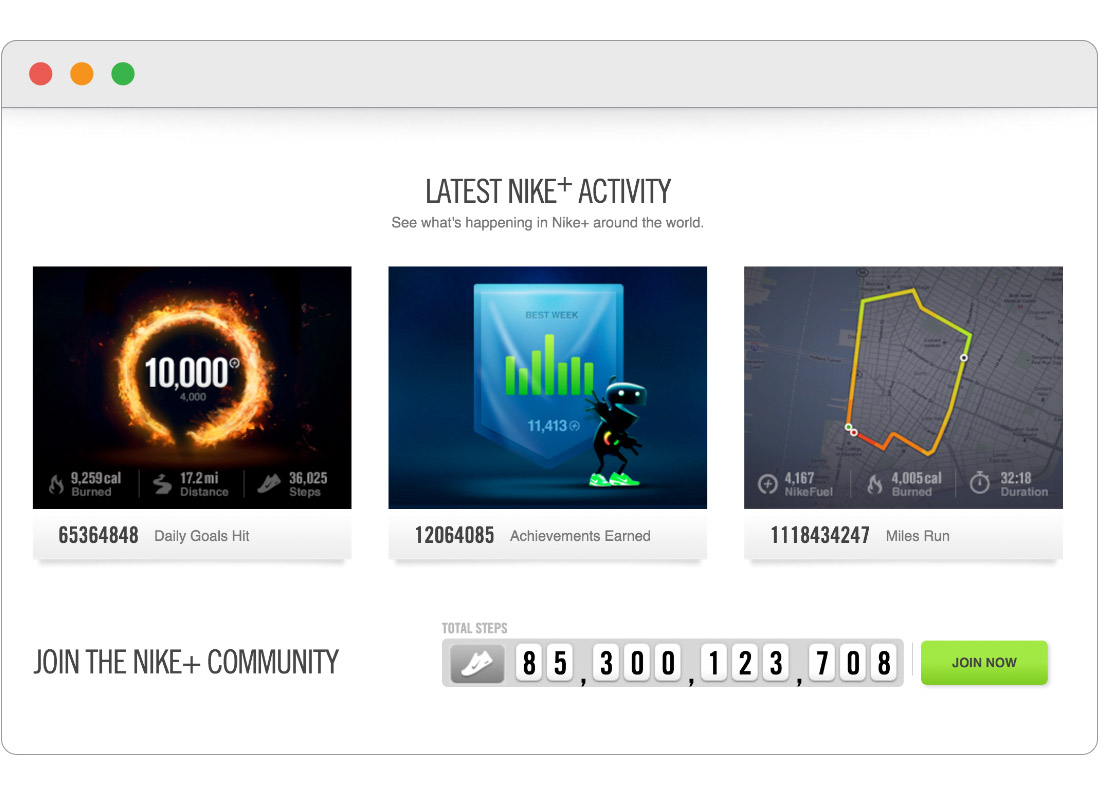
- Rypple’s performance review app offers real-time feedback – Wondering how to improve the standard employee performance review process? Digital music service Spotify uses mobile app Rypple to allow managers and coworkers to give feedback and recognition in real-time.12 This social approach meets its employees’ preference for instant communication – and helps everyone feel they’re contributing to the big picture.
- The Samsung Nation social rewards program takes interactive websites to the next level – Samsung Nation is designed to help users discover the Samsung.com website. Visitors can earn badges and “level up” by reviewing products, watching videos and participating in user-generated Q&As.13 The combination of activities and rewards engages existing Samsung enthusiasts and creates brand new ones.
Crowdsourcing
The power of group motivation
Crowdsourcing is harnessing the collective wisdom of a community to answer questions or solve complex challenges. Think of it as brainstorming on a large scale. Wikipedia is a well-known example of crowdsourcing, one where people volunteer their time and knowledge for the cause. To further motivate people to contribute to crowdsourcing initiatives, just add some competition and rewards. Here are a few notable examples where crowdsourcing intersects with the principles of gamification.
- Volkswagen – To gather ideas for its new product line in China, Volkswagen used a crowdsourcing competition. Users submitted ideas into a virtual suggestion box and the top three concepts were presented at leading Chinese auto shows. Payoff to VW? 33 million website hits, a ton of inventive ideas and countless insights into the preferences of customers. Volkswagen continues the practice today.14
- Lego – Ever had an idea for a new Lego set? On Lego IDEAS, your vision may become reality. Users share a project description on the site and gather online support. 10,000 supporters qualifies your project for Lego review, where marketing and design representatives choose new products to be manufactured and sold around the world.15
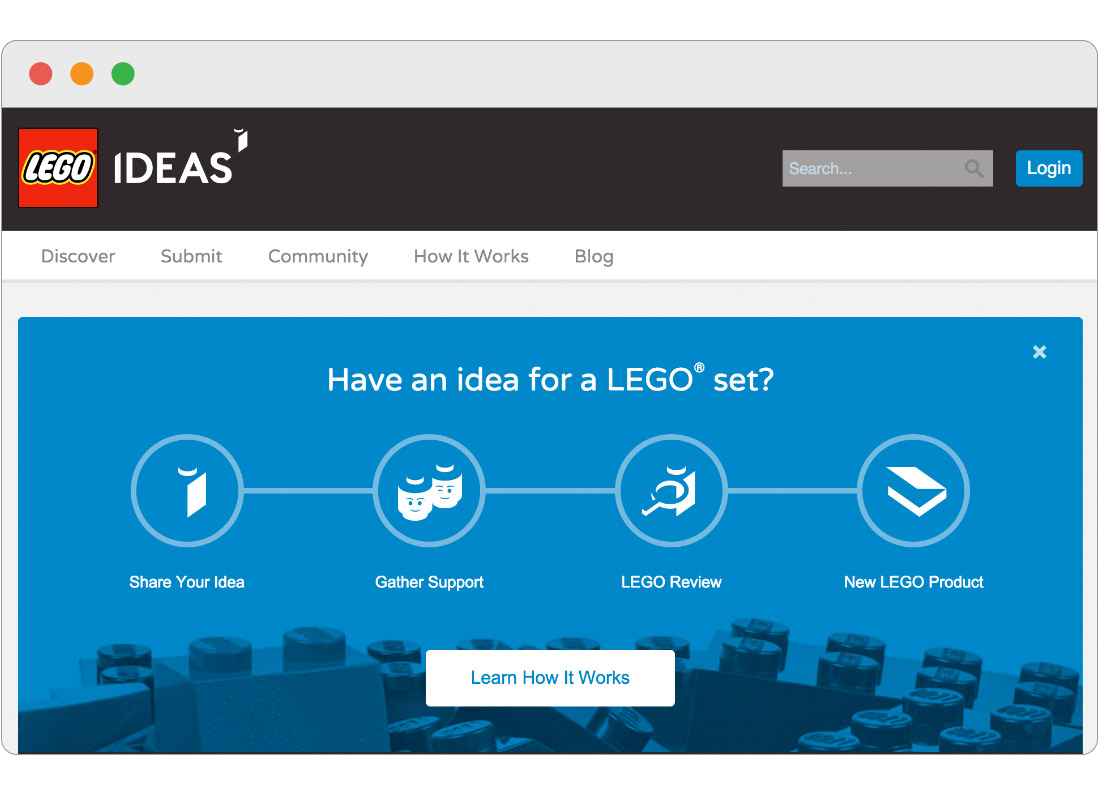
- Syngenta – The global crop sciences company has developed various programs to encourage collaboration and new ideas from third parties. Syngenta Thoughtseeders reaches out to R&D scientists for partnership opportunities.16 The Good Growth Plan, an initiative addressing the challenge of sustainably feeding the growing global population, held a contest offering grants for the best idea submissions.17
- Foldit – Games are not only providing a platform for innovation in R&D – they’re helping to cure diseases! Foldit is an online game that challenges players to fold proteins. The way proteins are folded – that is, their shape – determines their biological function and can give us clues about how to prevent or cure diseases. In 2011, gamers solved the riddle of an HIV enzyme’s structure (a challenge which had stumped scientists for a decade) in just three weeks – allowing researchers to target drug treatment.18
Gamification for B2B
Gamification is a natural for B2C applications where marketers are looking to build brand engagement. But what about B2B applications? MarketingSherpa outlines gamification tactics that can offer greater reach.19
- Online communities allow participants – including employees, consumers and business partners – to share and interact about products and services. Drive online community engagement by giving users who help others badges or rankings.
- Your company website is the first and best avenue for hooking a potential customer. Help them learn about your product with a series small tasks or “missions,” such as downloading papers, watching videos or answering quizzes for a chance at a prize.
Transform work into play for employees
Companies have traditionally used game techniques – such as levels, points or scoring – to motivate and help reward their sales teams. Organizations have now extended the use of gamification to the greater employee population. Imagine awarding points to employees for desired behaviors such as attending training, working out in the company fitness center, collaborating across functions or even carpooling. Giving virtual badges to those who complete the basic level in an executive education course. Or offering prizes for keeping calls brief and closing sales in a call center environment.20
Engaging students with games
Gamification and online learning are standard in today’s classrooms. These strategies increase student engagement by encouraging selfmotivation and building critical thinking, organization, time management and technology skills. The Chatham Charter School, in North Carolina, uses game mechanics in English classes.21 Students are put into groups and earn “gold” for their group’s average assignment scores. With their earnings, students can purchase perks such as bonus points on homework, collaborative test-taking or the ability to change a project topic.
To promote its “Brain Games” series, which reveals the inner workings of the human brain, National Geographic launched a fully gamified website.22 Each episode of the series has its own dedicated page, where visitors can watch video clips, take challenges and test themselves with quizzes on that episode’s topic. The pages are colorful, interactive, engaging – and feature parallax scrolling and great large imagery.
Summary
B2B, B2C or internal communications. No matter your focus, there is a great game technique to help you reach your goal. Although game mechanics have been around for a while, companies are now finding that gamification is an effective – and expected! – part of their overall marketing and communications strategy. Games tap into our love of competition and connection and they create engagement through fun and reward. If you haven’t tried game techniques before, it’s time to play on!
Thank you for reading. Our team hopes this paper is a great resource on how you can effectively incorporate game techniques into your marketing and communications. If you have any questions, feel free to contact us!
Play again
References:
- Marketing Experiments
- Convince and Convert
- The Game Theorists
- ‘The Benefits of Play’ Ted Talk
- Forbes
- Pinterest gamifcation quotes
- For the Win
- Growth Engineering
- Recyclebank
- Nike+
- Techworld
- Samsung Nation
- The New York Times
- Lego IDEAS
- Syngenta Thoughtseeders
- Good Growth Plan
- Scientific American
- Marketing Sherpa
- Wall Street Journal
- Open Class
- BrainGames



